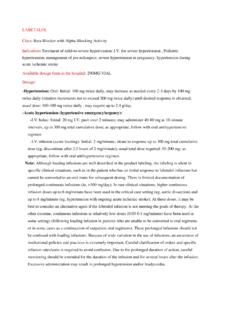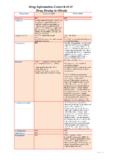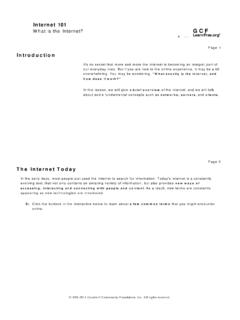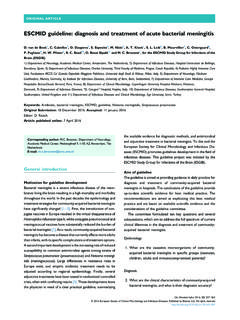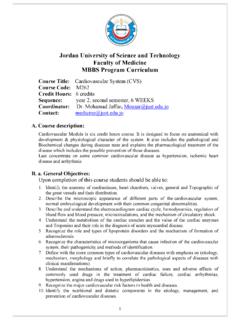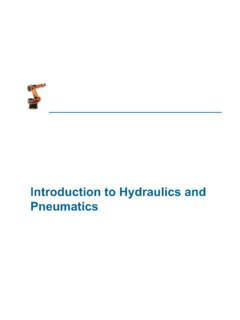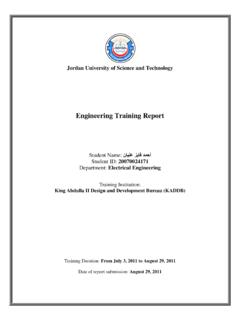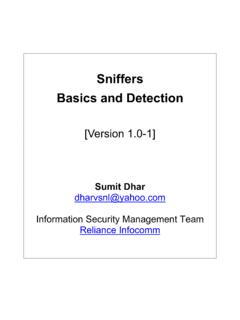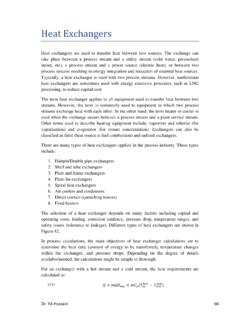Transcription of Comparison between New Oral Anticoagulants and Warfarin
1 Comparison between New oral Anticoagulants and Warfarin Warfarin was the mainstay of oral anticoagulant therapy until the recent discovery of more precise targets for therapy. In recent years, several new oral Anticoagulants (NOACs) have been introduced and more drugs are currently under development. These drugs have given patients and providers alternatives to heparin and Warfarin , mainly for prophylaxis against stroke in patients with atrial fibrillation (AF), prophylaxis/treatment of venous thromboembolism (VTE) and in treatment of acute coronary syndrome (ACS).
2 The NOACs fall into two broad categories: the oral direct factor Xa (FXa) inhibitors (rivaroxaban (Xarelto ) and apixaban (Eliquis ) ) and the oral direct thrombin inhibitor (dabigatran etexilate (Pradaxa ), the prodrug of dabigatran). Other direct FXa inhibitors being investigated in clinical trials are edoxaban and betrixaban and are pending approval at the moment. The NOACs differ from Warfarin in : - Mechanism of action because of direct inhibition of proteins of the coagulation cascade. - They have more predictable pharmacokinetics leading to fixed and convenient dosing regimens.
3 - No need for routine monitoring. - Rapid onset of action. - No interaction with food. Some of their limitations are the higher cost, limited monitoring (if needed, as only qualitative measures available) and the lack of a specific antidote. The following Table 1 show the pharmacokinetics characteristics and indications of the new oral Anticoagulants compared with Warfarin . Table 1. Pharmacokinetics characteristics and indications of the new oral Anticoagulants compared with Warfarin . Characteristics Warfarin Dabigatran Apixaban Rivaroxaban Betrixaban Edoxaban Molecular weight (Da) 308 628 460 436 452 548 Bioavailability (%) 98 6 7 66 63 79 40 80a 50a tmax (h) 72 120 2 3 1 3 2 4 NR 1 3 t1/2 (h) 20 60 7 17 8 15 7 13 5a 9 11 Protein binding (%)
4 99 35 87 95 NR 54 Food effect Yes Delayed absorption No Delayed absorption No No Dosing regimen once daily twice daily twice daily once daily once daily once daily Metabolism/elimination 100% liver 80% renal 20% liver 25% renal 75% fecal 1/3 renal 2/3 liver 5% renal 95% liver 35% renal 65% liver Substrate CYP 2C9, 3A4 No 3A4 3A4, 2J2 No 3A4 Substrate P-gp No Yes Yes Yes No yes Food interaction Yes No No No No NR Monitoring required INR No No No No No Target II, VII, IX, X, P-S, P-C II Xa Xa Xa Xa Antidote Yes No No No No No Typical effective dose INR guided 150 mg or 220 mg once daily (VTE prophylaxis)* 75 mg or 150 mg twice daily (AF) bid (VTE prophylaxis)* 10 mg once daily (VTE prophylaxis)* 15 mg twice daily (1 21) followed by 20 mg once daily (DVT treatment/prevention of recurrent VTE)$20 mg once daily (AF) In development 30 mg (VTE prophylaxis)
5 Approved indications Approved for VTE prevention and treatment of the thromboembolic complications associated with AF and cardiac valve replacement, and secondary prevention after MI Approved for VTE prevention after elective hip or knee replacement in adults and for prevention of stroke and systemic embolism in patients with nonvalvular AF Approved for VTE prevention after elective hip or knee replacement in adults. Stroke prevention and systemic emolization in nonvalvular AF Approved for VTE prevention after elective hip or knee replacement in adults, for prevention of stroke and systemic embolism in patients with nonvalvular AF, and for treatment of acute DVT and prevention of VTE recurrence Has not been approved yet Only approved in Japan for VTE prophylaxis joint replacement Renal Clearance of Warfarin and NOACs No dosage adjustment for Warfarin is necessary in renal impairment.
6 However, patients with renal failure have an increased risk of bleeding complications; so monitor closely. Given that all the NOACs are partially excreted by the kidneys, careful watch over the creatinine clearance (CrCl) will avoid excessive drug accumulation in the body. Dabigatran serves as a substrate for P-gp and although CYP3A4 has no role in its metabolism, changes in its bioavailability can be expected if other drugs that are strong P-gp inhibitors, such as amiodarone, verapamil, ketoconazole, quinidine or clarithromycin, or inducers such as rifampicin and St John's wort are used.
7 Adapted from Poulsen et al. [2012], Lip et al. [2012] and Perez et al. [2013]. ACS, acute coronary syndrome; AF, atrial fibrillation; CYP, cytochrome P450; DVT, deep vein thrombosis; INR, international normalized ratio; MI, myocardial infarction; NR, not reported; P-C, protein C; P-gp, P glycoprotein; P-S, protein S; t , terminal elimination half-life; tmax, time to reach maximal plasma concentration; VTE, venous thromboembolism. *Approved dose for VTE prevention in adult patients undergoing elective hip or knee replacement surgery. $Approved dose for treatment of acute DVT and prevention of recurrent DVT and PE.
8 Approved dose for prevention of stroke and systemic embolism in adult patients with nonvalvular AF. However, since a third of rivaroxaban is cleared by the kidneys, it has been approved for use in patients with severe renal insufficiency (CrCl level between 15 and 29 ml/min). On the other hand, CYP3A4 plays a role in the metabolism of rivaroxaban and drug drug interactions are quite likely if inhibitors and inducers of CYP3A4 are concomitantly administered. The following Table 2 shows the approved dosing for NOACs according to indication and renal function.
9 Table 2. Approved dosing according to indication and renal function. Drug and indication Renal function classification Normal CLcr 90 ml/min Mild CLcr 60 89 ml/min Moderate CLcr 30 59 ml/min Severe CLcr 15 29 ml/min End-stage renal disease CLcr <15 ml/min Dabigatran Atrial fibrillation/EMA 150 mg twice daily 150 mg twice daily 110 mg twice daily Contraindicated Contraindicated Atrial fibrillation/FDA 150 mg twice daily 150 mg twice daily 150 mg twice daily 75 mg twice daily$ Contraindicated VTE prophylaxis joint replacement 220 mg once daily 220 mg once daily 150 mg once daily Contraindicated
10 Contraindicated VTE treatment (not yet approved) 150 mg twice daily 150 mg twice daily 150 mg twice daily Contraindicated Contraindicated Rivaroxaban Atrial fibrillation 20 mg once daily 20 mg once daily 15 mg once daily 15 mg once daily Contraindicated VTE prophylaxis joint replacement 10 mg once daily 10 mg once daily 10 mg once daily Use with caution Contraindicated VTE treatment 15 mg twice daily/20 mg once daily 15 mg twice daily/20 mg once daily 15 mg twice daily/15 mg once daily 15 mg twice daily/15 mg once daily Contraindicated Apixaban Atrial fibrillation/EMA/FDA
